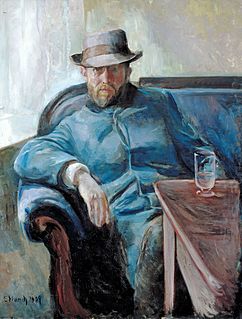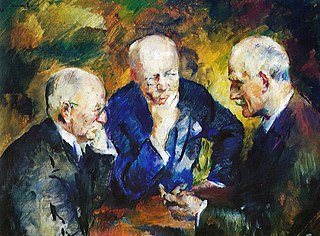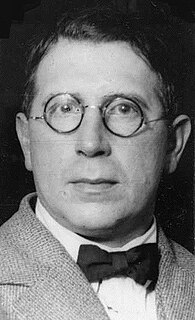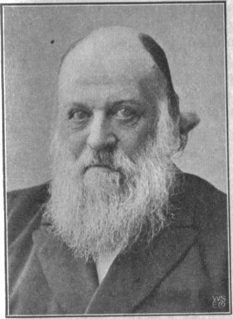| The Blue Kitchen | |
|---|---|
| Norwegian: Det blå kjøkken | |
 | |
| Artist | Ludvig Karsten |
| Year | 1913 |
| Medium | Oil, on canvas |
| Dimensions | 54 cm× 69 cm(21 in× 27 in) |
| Location | National Gallery, Oslo |
The Blue Kitchen (Norwegian: Det blå kjøkken; dated 1913) is the title of a neo-impressionist painting by Norwegian artist Ludvig Karsten, showing a kitchen table ready for breakfast, while the morning sun is shining through the window.

Neo-Impressionism is a term coined by French art critic Félix Fénéon in 1886 to describe an art movement founded by Georges Seurat. Seurat's greatest masterpiece, A Sunday Afternoon on the Island of La Grande Jatte, marked the beginning of this movement when it first made its appearance at an exhibition of the Société des Artistes Indépendants in Paris. Around this time, the peak of France's modern era emerged and many painters were in search of new methods. Followers of Neo-Impressionism, in particular, were drawn to modern urban scenes as well as landscapes and seashores. Science-based interpretation of lines and colors influenced Neo-Impressionists' characterization of their own contemporary art. The Pointillist and Divisionist techniques are often mentioned in this context, because it was the dominant technique in the beginning of the Neo-impressionist movement.

Painting is the practice of applying paint, pigment, color or other medium to a solid surface. The medium is commonly applied to the base with a brush, but other implements, such as knives, sponges, and airbrushes, can be used. The final work is also called a painting.

Norway, officially the Kingdom of Norway, is a Nordic country in Northwestern Europe whose territory comprises the western and northernmost portion of the Scandinavian Peninsula; the remote island of Jan Mayen and the archipelago of Svalbard are also part of the Kingdom of Norway. The Antarctic Peter I Island and the sub-Antarctic Bouvet Island are dependent territories and thus not considered part of the kingdom. Norway also lays claim to a section of Antarctica known as Queen Maud Land.
The Blue Kitchen is regarded among Karsten's most important paintings. It is located at the National Gallery in Oslo. [1] [2]

Oslo is the capital and most populous city of Norway. It constitutes both a county and a municipality. Founded in the year 1040 as Ánslo, and established as a kaupstad or trading place in 1048 by Harald Hardrada, the city was elevated to a bishopric in 1070 and a capital under Haakon V of Norway around 1300. Personal unions with Denmark from 1397 to 1523 and again from 1536 to 1814 reduced its influence, and with Sweden from 1814 to 1905 it functioned as a co-official capital. After being destroyed by a fire in 1624, during the reign of King Christian IV, a new city was built closer to Akershus Fortress and named Christiania in the king's honour. It was established as a municipality (formannskapsdistrikt) on 1 January 1838. The city's name was spelled Kristiania between 1877 and 1897 by state and municipal authorities. In 1925 the city was renamed Oslo.
In 1913 Karsten was newly married, and the couple moved from Copenhagen to the Norwegian island Hvasser. Sources differ whether Blue Kitchen is painted in Copenhagen or Hvasser. The painting was bought by art collector Christian Tetzen-Lund in 1913. In his notebook he called it Det blaa Vindue, and he had paid a price of 125 kr. The blue Kitchen was first publicly exhibited at The Autumn Exhibition in Kristiania in 1913, and also at an exhibition in Copenhagen later the same year. The National Gallery acquired the painting after offering a price of 800 kr. [2]

Copenhagen is the capital and most populous city of Denmark. As of July 2018, the city has a population of 777,218. It forms the core of the wider urban area of Copenhagen and the Copenhagen metropolitan area. Copenhagen is situated on the eastern coast of the island of Zealand; another small portion of the city is located on Amager, and is separated from Malmö, Sweden, by the strait of Øresund. The Øresund Bridge connects the two cities by rail and road.
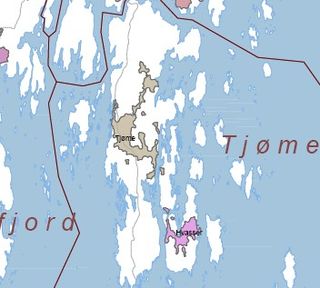
Hvasser is a populated island and a village in Færder municipality, Norway, connected to mainland and the city of Tønsberg via the islands Brøtsø, Tjøme and Nøtterøy. The name comes from the Norwegian word "hvass", meaning sharp, which is owed to sharp cliffs on the island. The island is 3.6 km2 and the village of Hvasser is located on the center of the island. It is on the western shore of the Oslo Fjord, 25 km (15.5 mi.) south of Tønsberg. The island is a popular summer holiday destination. It is home to various hiking trails and bathing beaches. In Sandøsund is a harbor, restaurant, gallery, and general store.

Høstutstillingen or Statens kunstutstilling is an annual art exhibition in Oslo, Norway. The exhibition is Norway's largest marking of contemporary art and takes place each autumn. It is arranged by Norske Billedkunstnere. The exhibition is set up on the basis of free submission. Den nasjonale jury, which is responsible for the assessment of the submitted work, consists of a technician in each of the techniques painting, sculpture, graphics, drawing, textile, and other techniques.


